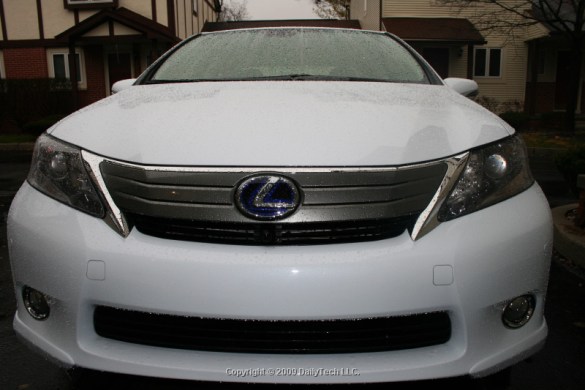 In past weeks we looked at our test-drive experiences with the 2010 Toyota Prius (third generation) and the 2010 Lexus RX 450h (hybrid SUV). Our most recent test-drive acquisition has been the Lexus HS 250h. We took it out for a week long adventure and have formulated our thoughts on it.
In past weeks we looked at our test-drive experiences with the 2010 Toyota Prius (third generation) and the 2010 Lexus RX 450h (hybrid SUV). Our most recent test-drive acquisition has been the Lexus HS 250h. We took it out for a week long adventure and have formulated our thoughts on it.
First, let’s look at the vehicle itself and why it’s been such a hot seller in Japan and promises to be an equally great sales success in the U.S. The 2010 Lexus HS 250h (HS stands for “harmonious sedan”, a very Japanese title) starts at $34,200 – typical for an entry-level sedan from a tier 1 luxury brand. This is relative bargain compared to other Lexus luxury hybrid sedans — the 2010 Lexus GS 450h, priced at $56,550 and the 2009 Lexus LS 600h, priced at $106,035.
For your money, the Lexus HS gives you some attractive luxury and eco-friendly features — Smart Access, push button start/stop, a HomeLink universal transceiver (can accomplish functions like closing your garage door), UV-reduction windshield glass, bioplastics (from sources including kenaf fibers and castor seeds), an OLED gauge cluster, a 10-speaker premium sound system, XM radio, LED taillamps and more. LED headlamps, a backup camera, and a navigation system are all optional packages/features.
From a performance perspective, the sedan has 187 net horsepower (from a 2.4L 2AZ-FXE inline-four engine and a 40 hp electric motor). This compares comes favorably to the Toyota Prius (134 hp combined, via electric motor and 1.8L engine). 0-60 mph acceleration for the small four-door is around 8 seconds. Meanwhile, the sedan’s fuel economy of 34 mpg (combined) stacks up between the Prius’s industry-leading 50 mpg combined fuel economy and the Lexus LS/GS’s not so great fuel economies (21/23.5 mpg, respectively).
Driving the Lexus HS, the first thing that popped out was a bit of a negative — one of only a handful that marred the experience. The car has one of the smallest automatic shifter sticks that we’ve seen. We’ve seen small knobs, but this thing was tiny — nearing the size and average thickness of a human thumb (though a bit wider at its crest). In fact, we dubbed it the “fairy stick” due to its diminutive size. This stick marred the car’s look — we’re not quite sure what the designers were thinking. Fortunately, the situations in which you have to interact with the unsightly little stick were limited.
Otherwise the seats were comfortable (bioplastics and all) and our model came with the LED headlamps, which were very bright and clear. Our vehicle also came with the navigation package, and the display was bright enough to be easily read.
In terms of on road performance, we averaged 36 mpg over 345 miles, slightly better than the EPA estimates. While not as efficient as the Prius, this meant that we still weren’t on empty even after a long week of driving. The disc brakes were extremely responsive and not overly jumpy — regenerative braking is usually a low-point with hybrids. Acceleration was smooth, but is largely a matter of perception. Moving up from the Prius, it will feel powerful, but for those who have experienced the LS/GS hybrids, it feels underpowered (but that sacrifice seems worth it, to us, as the fuel economy is significantly improved). NVH is very low — inside the cabin is quite quiet. The car absorbed potholes on a poorly maintained Detroit street with aplomb, offering minimal jostle to the passenger.
Overall the sedan seemed a relatively good value for its price. A couple more minor complaints were the “feature” auto-dimming mirrors. For those easily distracted, they may be a good idea, by minimizing incidental glare. However, for those with good vision, they prove to be a headache as it’s hard to see vehicles at night in them, particularly those with dim headlights. We’d rather deal with a bit of glare and retain the ability to actually see what’s coming at us. Perhaps a future implementation can fix these problems.
Our other minor gripe was that the remote unlock on the trunk did not seem to work (it could have just been our unit) and the trunk seemed (in general) hard to open. These detractions considered, we still enjoyed our time with the vehicle and felt that it’s definitely something for entry-level luxury buyers to consider.




